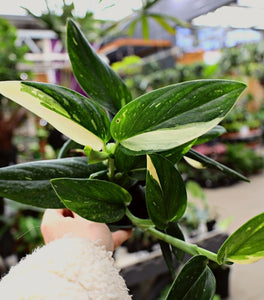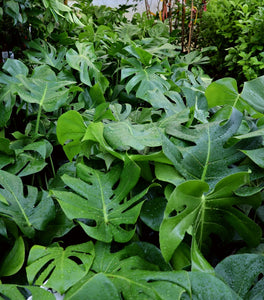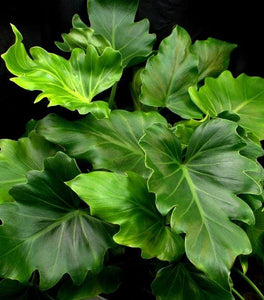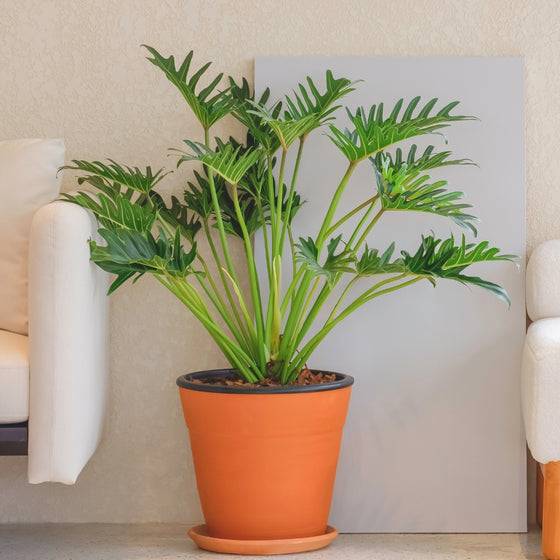
Images Depicted Range in Maturity & Container Size
Pots & Decorations Not Included Unless Otherwise Stated
Philodendron Xanadu for Sale Online
The Philodendron Xanadu (Thaumatophyllum Xanadu) is a rare variety of houseplants that is perfect if you're searching for a unique statement piece to light up your space! This large tropical plant boasts dinner-plate-sized, multi-lobed leaves in a bushy growth habit.
If you love the popular Split-Leaf Philodendron or the Lickety-Split Philodendron, the Xanadu is certainly one you will want to add to your collection! Proper Philodendron Xanadu care includes bright indirect light and well-draining soil. Because of their tropical origin, these houseplants also enjoy high temperature and humidity levels.
Beyond the basics, we would also recommend feeding your plant with a liquid fertilizer in the growing seasons of spring and summer to provide it with all of the necessary nutrients for optimum results.
When grown properly, you can expect your Xanadu Philodendron to grow nearly 3-5 feet tall and wide. It is important to note that this plant is toxic to animals and humans, so it is important that you grow it in a place that is out of reach of children and your furry friends!
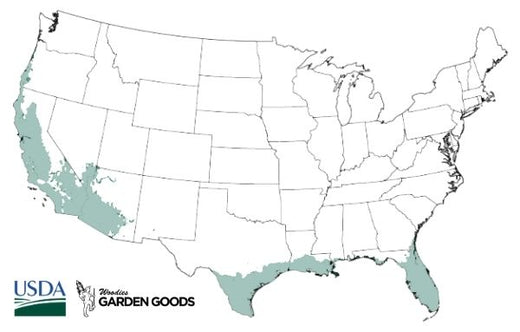
| Hardiness Zone: | 9-11 |
|---|---|
| Mature Height: | 24 to 48 Inches |
| Mature Width: | 24 Inches |
| Classification: | Tropical |
| Sunlight: | Fluorescent light to bright, indirect |
| Habit: | Bush-like |
| Flower Color: | Does not flower |
| Foliage: | Dark green, glossy |
| Soil Condition: | Well draining, cactus or succulent mix (part sand) |
| Water Requirements: | Likes to go dry |
| Uses: | Does well indoors and in low light conditions |
How to Care for Philodendron Xanadu
Be sure to read our planting instructions to ensure a healthy and happy plant for years to come!

What is the best light for Philodendron Xanadu?
Philodendron Xanadu thrives in the low light conditions indoors, living with just fluorescent light. These plants can handle some bright, indirect light, but too much light will cause the plant to brown. We recommend placing them near a south or north-facing window. This plant will grow towards the direction they receive light. You should rotate your plant every few days to ensure it receives sun on all parts of the plant and the stem doesn't start to slant.
How often should I water Philodendron Xanadu Plants?
Philodendron Xanadu Plants do like to dry out between watering. However, when you are watering, make sure you water your plant thoroughly to ensure its root system receives plenty of water. It is crucial to pot your Philodendron plant in a container with drainage holes. The holes will allow excess water to drain out and not create root rot disease. This houseplant loves humidity, so feel free to mist its leaves early in the morning to help create a humid environment. If you are unsure whether or not to water your plant, we recommend holding off a day or two to ensure you don't overwater.

What is the best soil for Philodendron Xanadu Plants?
Philodendron Xanadu Plants prefer well-draining soil and prefer to have dry conditions. Regular potting mix with sand mixed in works well for plants potted in containers. Otherwise, a cactus potting mix would work. The cactus potting mix already has sand and other ingredients to encourage drainage. Always remember to pot your Philodendron in a container with drainage holes. These will help prevent any chance of root rot disease. The disease happens when your plant's roots are submerged in water for too long because of improper drainage.
How do I fertilize Philodendron Xanadu Plants?
You can use a diluted regular houseplant fertilizer on your Philodendron Xanadu plant. We recommend feeding your plant once a month during the growing seasons of spring through fall. However, be careful not to over-fertilize your houseplant because this could cause an excess salt build-up in the soil and cause your plant's leaves to burn. Avoid this by giving your plant a thorough watering before fertilizing to ensure your plant soaks up all the nutrients it needs. Also, do not fertilize your plant during its growth dormancy season. Doing so could cause your plant's next growing season to be lackluster.












